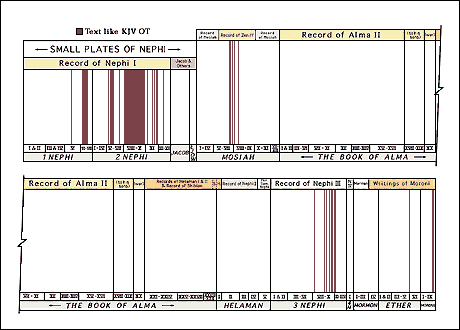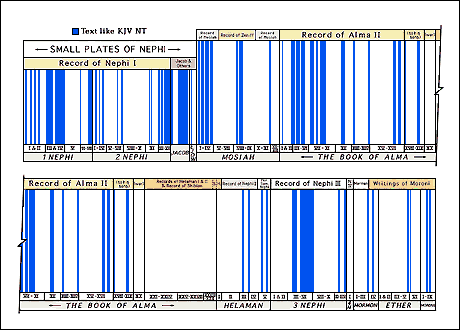Brent Metcalfe wrote:
Good grief, Dale; the fact that Joseph Smith did not write KJV Isaiah is one of the two very
controls that I’ve alluded to for testing whether Smith alone was responsible for the
“therefore”/”wherefore” lexical shift. *sigh*
Don't think that I am trying to be difficult here for no purpose, Brent. I know quite well what you said in your
paper (or, rather your chapter, in the form I have it). It is your attempt to make that material relevant to the
topic at hand that now interests me; and not the several details of your research and reporting.
If you wish to show exactly how those details relate to this discussion, that might prove interesting for all of
us reading your remarks in this thread. But since you do not seem ready to do much of that yourself, I'll here
attempt to make one of your critics speak in your behalf:
FARMS wrote:"Metcalfe believes that 'occurrences of ‘therefore’ and ‘wherefore’ in Book of Mormon passages
deriving from the King James Version of the Bible (KJV) elucidate the interplay between narrative
created by Smith and narrative dependent on external sources' (p. 411). To illustrate, he notes that
Joseph Smith “tends to retain [or] delete, but not alter the term ‘therefore’ or ‘wherefore’ in a biblical
source he is copying,” even if it is not the one he is currently using in the adjacent text, while favoring
his own term whenever embellishing the biblical source. While this indicates to Metcalfe that Joseph Smith
was simply taking Bible passages and building the story of the Book of Mormon around them, it need
not be so. It is just as likely that he employed the KJV reading of Bible quotes in the Nephite record..."
(John A. Tvedtnes' review)
Notice the
a priori deductive reasoning by which you begin that statement, and by which your
critic continues the idea: "Joseph Smith 'tends to retain [or] delete...' in a biblical source he is copying."
In other words both you and Tvedtnes simply assume that the textual oddities pointed out in the Book of Mormon come
via the editorial and creative hand of Joseph Smith, Jr.
To my way of thinking, this is a poor way to begin an assertion of this magnitude of importance.
But, back to my earlier qustion -- as to whether Smith wrote Isaiah?
Of course he did not -- and for me, at least, that makes the Book of Mormon a composite text. You, however, appear to
be very reluctant to make that admission: you just direct us all back to your article, as though it were an alabaster
keystone, inset above the entrance to the Court of the Gentiles, with an imperial decree set in golden letters. So
of course, people like myself are not going to let such a directive stand, without further elucidation.
But I think I fathom your intent, in pointing to the biblical material copied over into the Book of Mormon (by whomever),
but without identifying the results as comprising a composite text. For, were you to come right out and admit
that fact, in doing so you would naturally leave open the probability that where a composite text incorporates
pre-existing biblical material, it will also incorporate pre-existing material from other sources.
The further you hold open that possibility, the more likely it will be that something like a Solomon Spalding
fragment (or more) found its way into the Book of Mormon.
And, by operating under the
a priori assumption that Smith (and Smith alone) was the one who plagiarized
the KJV Bible, you can continue to give the impression that the biblical borrowings are merely a sort of added
"seasoning" for Smith's literary soup -- and not really blatant indicators of a composite text.
I find it telling that you are perfectly ready, willing and able to leap upon some insignificant small detail in my
charting out of
Spalding textual affinities, but that you allow my biblical borrowing assertions to fly by
with a passing grade.
Let us take a quick look back at my 1980 JWHA paper and the biblical text borrowings I charted out there:
 Figure III: Distribution of Book of Mormon Texts Typical of the Old Testament
Figure III: Distribution of Book of Mormon Texts Typical of the Old Testament
 Figure IV: Distribution of Book of Mormon Texts Typical of the New Testament
Figure IV: Distribution of Book of Mormon Texts Typical of the New Testament
Now there are two charts to which you might have directed your critical attention -- and in the process pointed
out to me the several errors I made in my graphic over-generalizations, by which several Old Testament borrowings are
left out of the chart, and by which some purported New Testament borrowings might be shown to be simply the author's
mimicry of Elizabethan English, etc.
But, like Lester E. Bush and Wayne Ham before you, it appears that you have no bones to pick with this sort of
stuff. I presume that it does not bother you, because it leaves your
a priori deductive reasoning largely
unassailed and unharmed.
So, you instead have directed your attention to what you presume were the data that went into making up my
other chart in that series:
 Figure II: Distribution of Book of Mormon Texts Resembling Spalding's Writings
Figure II: Distribution of Book of Mormon Texts Resembling Spalding's Writings
Fine and dandy -- this is stuff I'd rather talk about anyway, Brent.
But why do you not come right out and say what it is that bothers you about my presentation of this material?
All your talk about the signifigance of "more part" has nothing to do with this Spalding stuff. And when I credit
the "more history part" of Alma to Spalding's pen, you really need to come up with some better response than
to tell me and others to read you paper --- where Solomon Spalding is mentioned zero times and Rigdon's name
pops up only once.
In 1956 my grandmother slipped and fell upon a department store in Idaho, was badly injured, and brought a
suit in court against the store. The store chain lawyers offered her several thousand dollars to drop the suit,
and gave her papers to sign to that effect. When she tried to collect the money promised her, those same lawyers
pointed out that she had dated her signature "1958" instead of "1956," which made the agreement null and void.
She threatened to go back into court, and they handed her some purchase vouchers to shut her up. She shut up.
I see your reference to the "more part" oddity in the text as exactly the same sort of thing as the lawyers were
trying to pull in my grandmother's situation. By the time they had finished with her, a typographical oddity in a
settlement agreement was made so seemingly large as to effectively blot out the fact of her documented injuries.
And, with your argument, Brent, a "more part" oddity is made so seemingly large, as to block out the readers'
view of Spaldingish language in certain parts of the Book of Mormon.
Greater things than my amateurish drawings are in the wind, Brent. Take care that you do not commit your
scholarly reputation so strongly to a "Smith-alone" position that you will not be able to bend in that coming wind.
With respectful regards,
Dale R. Broadhurst


